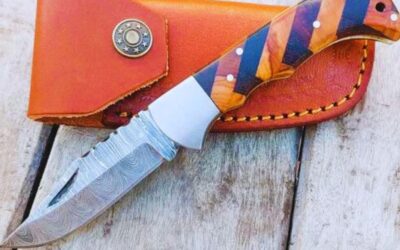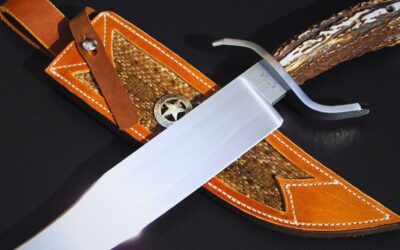Introduction
So, what exactly is a Damascus knife? If you’re picturing an ancient, beautiful blade with swirling patterns and a mystique that makes it look like something out of a legend, you’re on the right track. A Damascus knife is crafted from Damascus steel, famous for its distinctive wavy or mottled pattern. These knives have been revered throughout history, and their allure continues to captivate enthusiasts and professionals alike. Let’s dive into what makes these knives so special and why they’re still a big deal today.
The History of Damascus Steel
Damascus steel has its origins dating back to ancient times, particularly around 300 B.C. in the Near East. Named after the capital of Syria, Damascus, this type of steel was originally used to make swords renowned for their sharpness and resilience. Traditional forging methods involved a combination of different steels and iron, repeatedly heating and hammering them to create the distinctive patterns. These blades were legendary for their ability to maintain a sharp edge and their remarkable strength, making them highly sought after by warriors and collectors.
Characteristics of Damascus Knives
One of the first things you’ll notice about a Damascus knife is its unique pattern. This isn’t just for show—these patterns are the result of folding different layers of steel during the forging process. Each knife is essentially a work of art, with no two patterns being exactly alike. The material composition often includes a mix of high-carbon and low-carbon steels, giving the blade both hardness and flexibility. Performance-wise, Damascus knives are celebrated for their sharpness, edge retention, and overall durability.
The Making of Damascus Steel
Today, the process of making Damascus steel has evolved but still retains its core principles. Modern methods often involve advanced techniques and tools, yet the essence of folding and layering steel remains. The forging process starts with stacking layers of steel, heating them to high temperatures, and then hammering them into shape. This process is repeated multiple times to create the characteristic layers. The result is a blade with superior strength and a unique visual appeal.
Types of Damascus Knives
Damascus knives come in various forms, each suited to different purposes. Culinary knives are perhaps the most popular, prized by chefs for their precision and beauty. Hunting knives are another common type, valued by outdoors enthusiasts for their robustness and sharpness. Then there are collectible knives, often purchased by enthusiasts and collectors for their historical value and craftsmanship.
Why Damascus Knives Are Special
There are several reasons why Damascus knives stand out. Firstly, the visual appeal of the intricate patterns makes each knife a piece of art. Secondly, the strength and durability of Damascus steel mean these knives can handle tough tasks without losing their edge. Lastly, the edge retention is superb, allowing the knife to stay sharp for longer periods compared to other types of blades.
Applications of Damascus Knives
Damascus knives aren’t just beautiful; they’re highly functional too. In everyday use, they make excellent kitchen companions for slicing, dicing, and chopping. In the professional culinary world, chefs favor them for their sharpness and reliability. For outdoor and survival enthusiasts, these knives offer durability and sharpness, making them ideal for tasks like skinning game and cutting wood.
Caring for Your Damascus Knife
To keep your Damascus knife in top shape, proper care is essential. Cleaning should be done by hand with mild soap and water, avoiding the dishwasher. Sharpening can be done using whetstones or professional sharpening services to maintain that razor-sharp edge. When it comes to storage, using a knife block or magnetic strip can prevent damage to the blade and maintain its pristine condition.
Comparing Damascus Knives to Other Knives
When you compare Damascus knives to stainless steel knives, you’ll find that Damascus blades offer better edge retention but might require more maintenance to prevent rust. Compared to high-carbon steel knives, Damascus knives provide a balance of hardness and flexibility. Meanwhile, ceramic knives might stay sharp longer without maintenance but are more brittle and prone to chipping.
Choosing the Right Damascus Knife
Selecting the perfect Damascus knife depends on several factors. Consider what you’ll use it for—culinary, outdoor, or collectible purposes. Look at the quality of the steel, the reputation of the maker, and your budget. Recommendations for different uses can help guide you to the right choice, ensuring you get a knife that meets your needs.
Myths and Misconceptions
There are many myths surrounding Damascus steel. Some believe it’s an ancient secret that can’t be replicated today, which isn’t true—modern smiths have mastered the art. Another misconception is that all Damascus knives are extremely expensive. While high-quality ones can be pricey, there are also affordable options available that offer great performance.
The Future of Damascus Knives
The world of Damascus knives is ever-evolving. Innovations in forging techniques continue to push the boundaries of what’s possible, making these knives more durable and intricate. The trends in the knife-making industry show a growing appreciation for artisanal craftsmanship. As more people discover the beauty and functionality of Damascus knives, their popularity is likely to keep rising.
Famous Damascus Knife Makers
Several artisans and brands have made significant contributions to the world of Damascus knives. Bob Kramer is a legendary figure in knife-making, known for his incredible craftsmanship. Brands like Shun and Zwilling also produce high-quality Damascus knives. Knowing how to spot authentic craftsmanship can help you make an informed purchase.
Where to Buy Damascus Knives
When looking to buy a Damascus knife, consider trusted retailers and online stores. Look for sellers with good reputations and positive reviews. Pay attention to what to look for when buying, such as the pattern quality and steel composition. Be aware of red flags and how to avoid scams, ensuring you get an authentic and high-quality knife.
Conclusion
In summary, Damascus knives are much more than just cutting tools. They are a blend of history, artistry, and functionality. From their unique patterns to their superior performance, these knives offer a distinctive experience whether you’re a chef, an outdoor enthusiast, or a collector. By understanding their history, characteristics, and proper care, you can truly appreciate what makes Damascus knives special.
FAQs
How do I identify real Damascus steel?
Real Damascus steel typically has unique, wavy patterns that are part of the metal itself, not etched or printed. Authenticity can often be verified by purchasing from reputable sellers and brands.
Are Damascus knives worth the investment?
Yes, for many people, they are worth it due to their combination of beauty, durability, and performance. They are particularly valued by chefs, collectors, and knife enthusiasts.
Can Damascus steel rust?
Yes, Damascus steel can rust if not properly cared for. It’s important to keep the blade dry and clean after use and occasionally oil it to prevent rust.
How often should I sharpen my Damascus knife?
The frequency of sharpening depends on usage. Regular honing can keep the edge aligned, but professional sharpening might be needed every few months with frequent use.
What’s the best way to display a Damascus knife?
Displaying a Damascus knife can be done using a magnetic strip, knife block, or a dedicated display case, ensuring the blade is protected and easily admired.




0 Comments